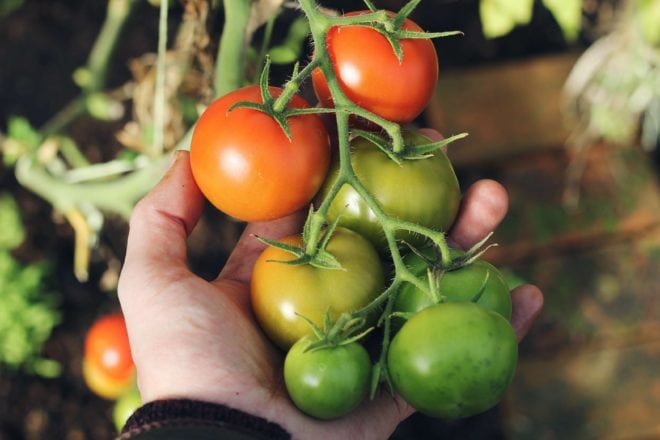Table of Contents
Overview [How To Dehydrate Tomatoes]
Tomato or Solanum Lycopersicum is an edible red berry and believed to have originated from the Aztecs. The Aztec (Nahuatl) word tomato means “the swelling fruit”. The Spaniards during the colonization of the Americas and in contact with the Aztecs called this fruit tomate which became the English word tomato after being introduced to the other European countries.
Tomatoes can be eaten raw or cooked. It could also be an ingredient in many dishes, sauces, salads, and drinks.
While tomatoes are fruits botanically classified as berries, they are culinarily classified as vegetables.
Raw tomatoes and tomato products can be kept refrigerated but will spoil over time due to bacteria, yeasts, and molds. Dehydrate tomatoes to make them last longer. You can also freeze, or pickle them, too.
/təˈmeɪtoʊ/ or /təˈmɑːtoʊ/?
In 1937, Ira and George Gershwin composed a song called “Let’s Call the Whole Thing Off”. This became the song in the movie “Shall We Dance” starring Fred Astaire and Ginger Rogers. The song goes:
“You like potato and I like potahto
You like tomato and I like tomahto
Potato, potahto, Tomato, tomahto
Let’s call the whole thing off”
The song became the symbol of the dual pronunciation debates between American and British English. Americans pronounce it as /təˈmeɪtoʊ/ [from Wikipedia] or \ tə-ˈmā-(ˌ)tō [from Merriam-Webster]. The British pronounce it as /təˈmɑːtoʊ/ or \ tə-ˈmä-(ˌ)tō respectively. Both are correct.
Is a Tomato a Fruit or a Vegetable?
Another topic being debated upon is how tomatoes are classified. Botanically speaking, tomato is a fruit, under the sub-group of berries. It consists of an ovary, seeds, and a flowering plant.
In the culinary world, it is a vegetable because it has lower sugar content than other fruits and it is typically served as part of a salad or an ingredient in a meal rather than as a dessert.
In 1887, the lowly tomato became the center of a debate in history. The U.S. tariff laws impose duties on vegetables but not on fruits. Is the tomato a vegetable or a fruit? The U.S. Supreme Court declared on May 10, 1893, that the tomato is a vegetable-based on the definition that classifies vegetables by use. They are generally served in dinner but not as a dessert. However, this ruling only applies to the interpretation of the tariff law and does not reclassify the tomato for botanical or other purposes.
They’re All One and the Same Tomato
Tomato varieties are based on shapes and sizes. There are a lot of varieties or cultivars around the world. Here are just a few examples:
- Beefsteak tomatoes – big, mostly pink or red, measures 4 inches or more in diameter, with pronounced ribbing, often used for sandwiches
- Plum tomatoes – cylindrical, pulpy, excellent for making tomato pastes, canned tomatoes, etc. Preferred variety in food processing
- Roma tomatoes – are variants of plum tomatoes, also called Italian tomatoes
- Cherry tomatoes – small, round, often sweet
- Campari tomatoes – round, sweet and juicy, but low acidity.
- Heirloom tomatoes – are popular among home gardeners and organic producers. These varieties have been bred for 40 years or more.
Garden of Tomatoes

Tomatoes are one of the basic vegetables that you could find in any home garden. Not only it’s easy to plant and grow one, but it’s also very productive. You could buy seeds from garden stores or you could find packets of seeds in groceries or supermarkets. These packets have instructions on how to plant and to take care of it.
If you only want fresh tomatoes, make three plants per person in your household. But we assume that you’re interested in drying tomatoes in summer so you’ll need 5 to 10 plants per person.
If you don’t have a garden, you can plant tomatoes in pots. Make sure you have holes under those pots as drainage. Place one tomato plant per pot. Cherry tomatoes grow best in pots.
Water your tomato plant generously during the first few days. Then water well throughout the growing season, about 2 inches per week during the summer. Do your watering early in the morning to give the plant enough moisture it needs throughout the day. As much as possible, do not water the plant during late afternoon or evening.
What does a tomato plant look like? It is straight and sturdy. About six to eight inches in height, with four to six true leaves. You may notice tiny little hairs along the stem. While growing, you need to tie them to stakes as support.
Once the fruit comes out, leave it alone until it develops its true ripe color. Ripe tomatoes are firm, bright and shiny in color. Sometimes, you may see some yellow remaining around the stem. You may pick them now. However, if they fall off before they appear ripe, put them inside a paper bag with the stem up and store it in a cool, dry dark place. The warmth from the paper bag will help ripen the fruit.
Some sources recommend not to refrigerate fresh tomatoes. This will spoil the flavor and texture.
Dehydrator-Dried Tomato
My grandmother used to dry tomatoes. She washes them first and slices them in half. She takes out the seeds, seasons them with salt, and place them in the food dryer. Depending on the size of the tomatoes, drying time would take 18 to 20 hours at 60°C to 70°C [140°F to 158°F]. But if you don’t take out the seeds, drying time would take 23 to 25 hours. Be sure to move them around every few hours so that they won’t stick to the trays.
However, the University of Georgia recommends pretreatment prior to drying tomatoes. Steam or dip tomatoes in boiling water to loosen skin. Then chill in cold water. Peel. Slice ½” thick or cut in ¾” sections. Dip in a solution of 1 tsp. citric acid per quart of water for 10 minutes. Dry for 6 to 24 hours until crisp. For more information about pretreatment, you may refer to this previous article.
If you’re a newbie on food drying, check out our recommended food dehydrators.
RELATED ARTICLE: NESCO® FD-60 Snackmaster Food Dehydrator
Sun-Dried Tomato
If you don’t have a food dehydrator and you’re living in a sunny part of the Earth, you can dry tomatoes under the sun. Place tomatoes cut side down, in a shallow wood-framed nylon screen tray. Cover the tray with another protective screen or cheesecloth. Place it in direct sunlight, raised from the ground or on blocks, or anything else that would allow air to circulate under the tray. Turn the tomatoes over after 1 ½ days to expose the cut side to the sun. Place the tray in a sheltered spot after sundown.
Remember that not all of the tomatoes will dry at the same time. Not all tomatoes have the same amount of moisture, Not all tomatoes have the same temperature and air circulation while they are drying, so make sure to check them from time to time during the drying process.
Rehydrating Dried Tomatoes
We must rehydrate dried tomatoes before cooking them. Rinse them under running water to get rid of any excess salt. Place them in a pot, cover them with enough water. Cook in high heat until it comes to a boil. Turn off the heat and let it steep until they are cool and fully rehydrated. Drain and pat dry.
If you are in a hurry, you may use the microwave oven to speed things up.
Dried Tomatoes in Oil

The best dried tomatoes are packed in extra virgin olive oil. It makes a good dressing or vinaigrette. To use them, simply drain and pat them dry with a paper towel to remove excess oil.
Some gourmet dried tomatoes in the market are packed with garlic, herbs, and even tuna. Be sure to read the label before using them.
Take note that it is not recommended to preserve fresh tomatoes in oil. Oil may protect microorganisms trapped in water. Also, the oil may have an effect on lid gaskets.
Nutritional Value
Tomatoes contain 95% water, 4% carbohydrates, and less than 1% fat and 1% protein. 100 grams of tomatoes may have 18 calories and 17% of our daily value of vitamin C. Although lycopene in tomatoes has been the rave for being anti-cancer or an antioxidant, all studies regarding lycopene are still inconclusive.
Final Thoughts
Tomatoes are excellent to dry either using a food dehydrator, oven, or even sun drying. They don’t need blanching, therefore it’s easy. Dried tomatoes can be rehydrated easily to be used in different dishes that require tomatoes.
Try our recipe using dried tomatoes by clicking here.
If you have any questions, comments, or suggestions


